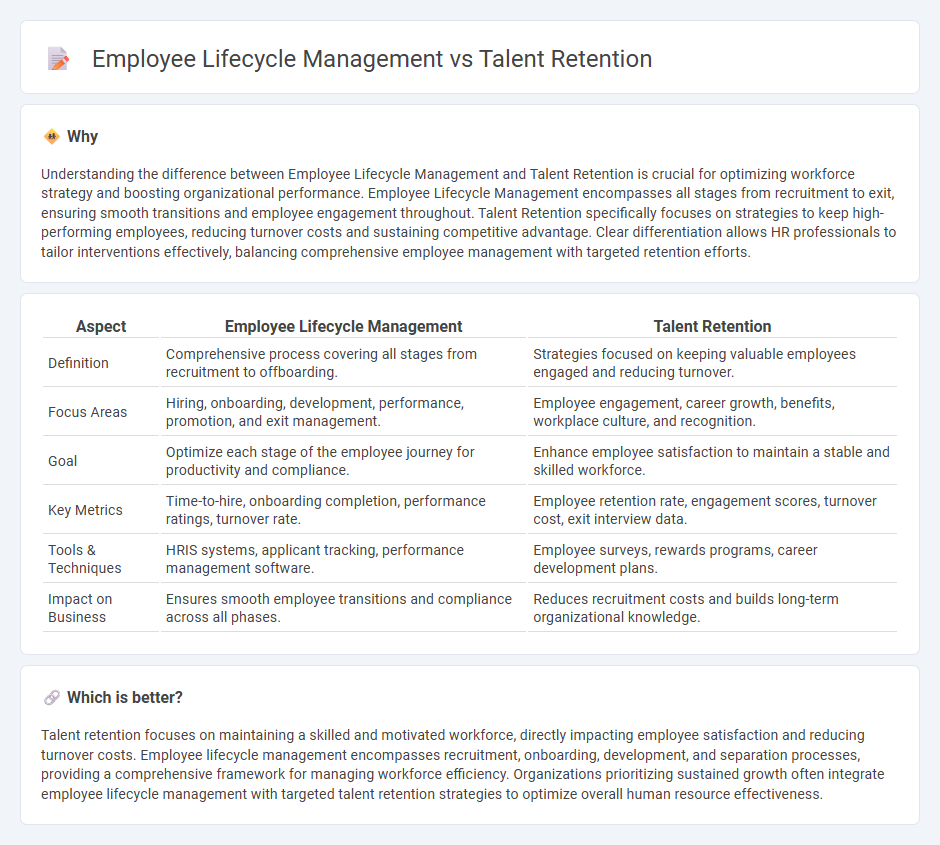
Employee lifecycle management encompasses the entire journey of an employee from recruitment to offboarding, focusing on optimizing each stage to improve performance and satisfaction. Talent retention specifically targets strategies to keep skilled employees engaged and committed, reducing turnover and its associated costs. Discover more about how integrating both approaches can enhance organizational success.
Why it is important
Understanding the difference between Employee Lifecycle Management and Talent Retention is crucial for optimizing workforce strategy and boosting organizational performance. Employee Lifecycle Management encompasses all stages from recruitment to exit, ensuring smooth transitions and employee engagement throughout. Talent Retention specifically focuses on strategies to keep high-performing employees, reducing turnover costs and sustaining competitive advantage. Clear differentiation allows HR professionals to tailor interventions effectively, balancing comprehensive employee management with targeted retention efforts.
Comparison Table
| Aspect | Employee Lifecycle Management | Talent Retention |
|---|---|---|
| Definition | Comprehensive process covering all stages from recruitment to offboarding. | Strategies focused on keeping valuable employees engaged and reducing turnover. |
| Focus Areas | Hiring, onboarding, development, performance, promotion, and exit management. | Employee engagement, career growth, benefits, workplace culture, and recognition. |
| Goal | Optimize each stage of the employee journey for productivity and compliance. | Enhance employee satisfaction to maintain a stable and skilled workforce. |
| Key Metrics | Time-to-hire, onboarding completion, performance ratings, turnover rate. | Employee retention rate, engagement scores, turnover cost, exit interview data. |
| Tools & Techniques | HRIS systems, applicant tracking, performance management software. | Employee surveys, rewards programs, career development plans. |
| Impact on Business | Ensures smooth employee transitions and compliance across all phases. | Reduces recruitment costs and builds long-term organizational knowledge. |
Which is better?
Talent retention focuses on maintaining a skilled and motivated workforce, directly impacting employee satisfaction and reducing turnover costs. Employee lifecycle management encompasses recruitment, onboarding, development, and separation processes, providing a comprehensive framework for managing workforce efficiency. Organizations prioritizing sustained growth often integrate employee lifecycle management with targeted talent retention strategies to optimize overall human resource effectiveness.
Connection
Employee lifecycle management provides a structured framework for tracking and supporting employees from recruitment through exit, which directly impacts talent retention by identifying engagement and development opportunities at each stage. Effective management of onboarding, performance reviews, and career progression enhances employee satisfaction, reducing turnover rates and fostering long-term commitment. Organizations that integrate lifecycle analytics with retention strategies can predict attrition risks and implement targeted interventions to maintain a stable and skilled workforce.
Key Terms
**Talent retention:**
Talent retention emphasizes strategies to maintain a skilled and motivated workforce, reducing turnover by fostering employee engagement, competitive compensation, and career development opportunities. Effective talent retention boosts organizational stability and reduces recruitment costs by ensuring high-performing employees remain committed. Discover more about optimizing talent retention to enhance your company's long-term success.
Employee engagement
Talent retention is a crucial component of employee lifecycle management, emphasizing strategies to keep skilled employees motivated and committed. Employee engagement directly influences retention rates by fostering a positive work environment, strengthening job satisfaction, and encouraging productivity throughout the onboarding, development, and retention phases. Explore effective employee engagement techniques to enhance talent retention and optimize your employee lifecycle management.
Turnover rate
Talent retention directly impacts turnover rate by reducing the frequency at which employees leave an organization, thereby stabilizing workforce productivity and lowering recruitment costs. Effective employee lifecycle management encompasses strategies from hiring to offboarding, addressing turnover by optimizing engagement, performance, and career development throughout each stage. Discover more insights on how managing employee lifecycle processes can significantly enhance talent retention and minimize turnover rate.
Source and External Links
Employee Retention - This article discusses strategies like realistic job previews, onboarding, training, and development opportunities to retain employees effectively.
Future of Talent Retention - This report highlights employee priorities such as health insurance and retirement plans, emphasizing the need for comprehensive retention strategies beyond salary.
Employee Retention Strategy Guide - This guide provides 25 strategies to retain top talent, including career development programs and improving company culture.
 dowidth.com
dowidth.com